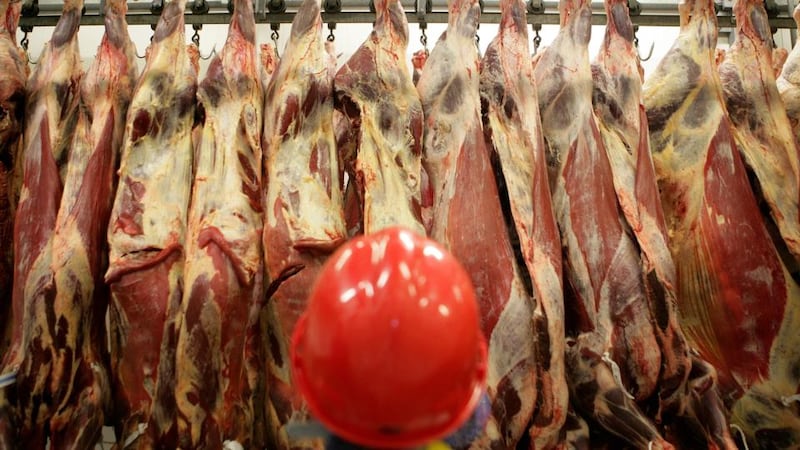As the temperatures soared in Washington DC this week, a delegation of Irish exporters, officials and representatives of the Department of Agriculture and Bord Bia arrived in the US capital for the start of a week-long trade visit to the US and Mexico.
Chief among them was Michael Creed, the Minister for Agriculture. Just days previously Taoiseach Leo Varadkar had reappointed the Cork Fine Gael TD to the agriculture brief. Was he happy to get the call?
“Was I what?” he beams, as we sit down for an interview in the Dupont Circle Hotel in Washington. “If I was to walk into the Taoiseach’s office and he said to me, ‘Take your pick of portfolios’ – which he didn’t, I hasten to add – this is the one I would want. It’s a tremendous industry.”


Creed faces a busy agenda as he begins his next stint at the helm of a department that is facing its fair share of challenges, not least Brexit. Britain's imminent departure from the European Union could strike a massive blow to Ireland's agrifood industry.
Some 40 per cent of Ireland’s total food and drink exports go to Britain. For beef, that percentage rises to 53 per cent.
Worst-case scenario
Creed doesn't pull any punches as he assesses the scale of the challenge. In a worst-case scenario – that Britain exits the single market without a deal and reverts to World Trade Organisation (WTO) rules – Irish beef exports could face a 60 per cent tariff and dairy a 50 per cent levy.
It would be unsustainable, he admits. “Look, we’re not turning our backs on the UK market. That supermarket space was hard won, and we’re not walking away from it, but equally we have to plan for the worst-case scenario of beef tariffs of 60 per cent and dairy tariffs of 50 per cent. We couldn’t put product into the UK on that basis.”
As a result his department is looking to help producers diversify into new markets, hence this week’s trade visit.
On Monday, the US department of agriculture granted our producers the right to carry a USDA-approved brand marketing Irish beef. That was accompanied by the news that Wexford-based Slaney Foods will supply beef to Lidl, as the low-cost supermarket chain embarks on its US expansion.
However, in reality the story of Irish beef in America has been disappointing. In 2015, Ireland became the first European country to gain access to the US market after the BSE crisis, winning permission to sell primal cuts.
In July last year, it was given the green light to sell minced beef, known in the trade as manufactured beef.
But despite predictions by then minister for agriculture Simon Coveney that the US could take up to 20,000 tonnes of Irish beef in 2015, the reality has been very different. Just 2,400 tonnes of Irish beef were shipped to the US last year, with the latest figures suggesting this year's figure will be even lower.
Falling prices
The main reason has been price. While beef prices were at a high when the market was reopened to Irish beef the price has since fallen as the US herd has increased, making exports to other regions more attractive for Irish producers.
Mr Creed says the decision about where to sell beef is ultimately one for the industry. “The job of the Department of Agriculture and Ireland Inc is to open the markets, the process after that is that the processors decide,” he says.
However, he is optimistic about further growth potential. "The average consumption in America of beef is 25kg per head of population. That's more than double what it is in Europe. They're big meat eaters here, so we see significant opportunities."
In particular, the opening of the minced meat market is likely to be more attractive to Irish exporters, while the award of the USDA-approved mark may allow Irish suppliers to tap the all-important retail market.
Speaking in Washington this week, Bord Bia chief executive Tara McCarthy said the agency had undertaken extensive consumer research that had shown a demand for the type of grass-fed, premium beef offered by Ireland.
In contrast, US beef is primarily corn-fed. Currently Irish beef, though sold in some US restaurants and provided to manufacturers, is not for sale on supermarket shelves.
In addition to the Lidl agreement with Slaney Foods, this week's trade delegation was due to meet with US supermarket giant Whole Foods Market, the high-end grocery store chain acquired by Amazon last week. Currently, Australian-supplied grass-fed beef is for sale in Whole Foods stores, alongside the array of US brands.
Cormac Healy of Meat Industry Ireland, who was part of the trade mission, disputes any suggestion that beef suppliers are not embracing the US market. "There is no question about the interest or intent of the industry in terms of selling to the United States. The industry has invested significantly in it, with 10 plants in Ireland now approved," he says.
Healy believes that last year’s extension of access to include manufacturing beef will be significant, as permission to provide primal cuts meant that only a limited number of plants had the ability to ship select cuts.
The Irish meat industry is also focusing on the potential for lamb exports. The sale of Irish lamb and sheep meat to the US is prohibited but the industry is hopeful that a regulatory audit by US authorities scheduled for September may bring change. “The US lamb market is only 50 per cent self-sufficient, so we believe we have a product that can really work in the US,” Healy says.
As well as this week’s drive to increase opportunities for Irish meat producers in the US, Irish officials are working within the broader context of the stalled TTIP (transatlantic trade and investment partnership) negotiations between the EU and the US as well as the Trump administration’s protectionist rhetoric.
Creed says he understands the concerns of the US industry. "I'm aware from conversations I have had with agriculture secretary Sonny Perdue that they have long-standing grievances about trade with the European Union, particularly on beef access. I acknowledge that. We would say the best way to deal with this is not now by US retaliatory strikes, in terms of sanctions against EU beef exporters – we would like to see these issues resolved in a round-table on TTIP."
Despite European farmers’ concerns about opening up of EU markets further to US beef, Creed says Ireland must embrace trade.
Balanced agreement
“We, more than any other country, must realise that it’s not for us to start building walls . . . We can’t operate on the basis that it’s all win for us and there’s nothing in it for the other party. It has to be balanced. I’m sure we can negotiate a TTIP agreement that will be beneficial for Irish farmers.”
This week’s visit also marked the start of engagement with Mexico on meat exports. Ireland does not export meat to the country, but does sell dairy products, such as infant formula. Creed met with the Mexican minister for agriculture, José Eduardo Calzada Rovirosa during the trip to Mexico City, and the hope is that Irish pork producers could tap the market.
“Mexico is a country of over 100 million people and a fast-growing economy,” says Creed. He notes that, while meat consumption is below the EU average in Mexico, it is on an upwards trajectory, in contrast to Europe where meat consumption is static, or slightly falling in the case of beef.
Other markets being targeted by agencies such as Bord Bia and the Department of Agriculture in the coming months as Brexit negotiations begin include Korea, and established markets within the euro zone such as Germany, France and the Netherlands, where currency fluctuations are not a concern.
Creed believes the department's job is to open doors into new markets for Irish beef producers. Winning USDA approval has been an important step in that direction.
“Being able to market our beef as grass-fed, family-farm produced puts us in the segment of the market where we really want to be, which is the valued-added high-premium end of the market. We’re not walking away from the UK market, but strategically our producers need to be planning for five years’ time. That is the challenge.”











